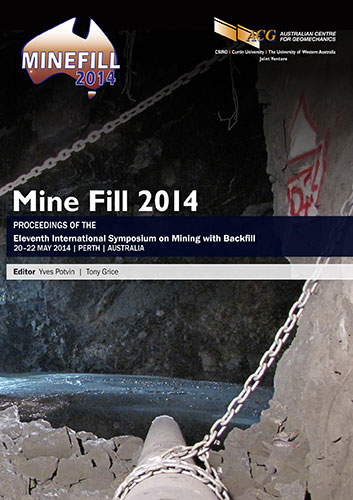New perspectives for cemented hydraulic fill with chemical technologies

|
Authors: Martic, Z; Gelson, J; Brás, H; Xu, Q; Brosko, W |
DOI https://doi.org/10.36487/ACG_rep/1404_23_Martic
Cite As:
Martic, Z, Gelson, J, Brás, H, Xu, Q & Brosko, W 2014, 'New perspectives for cemented hydraulic fill with chemical technologies', in Y Potvin & T Grice (eds), Mine Fill 2014: Proceedings of the Eleventh International Symposium on Mining with Backfill, Australian Centre for Geomechanics, Perth, pp. 295-308, https://doi.org/10.36487/ACG_rep/1404_23_Martic
Abstract:
Hydraulic fill (HF) made a breakthrough in the mining industry around the turn of the 20th century and by the 1950s, with the addition of cement, it became a major backfill technique that significantly changed mining operations and output. Cemented hydraulic fill (CHF), was a major step forward compared to the existing bulk backfill techniques of the day. Cemented hydraulic fill provided better continuity in the backfill production and placement, improved reliability of the backfilling process, increased backfill production and mine production in general, simpler scheduling processes and start-up operation. However, CHF started to lose favour to newer backfilling technologies, such as paste backfill due to a number of difficulties. These were high water content requirements (large amounts of water needed for transportation), loss of binder during drainage, presence of slimes in drained water, costly dewatering, barricade safety, and non-uniform properties of the placed fill. Recent studies done by BASF have shown that, with the help of admixtures, it is possible to improve the flowability and uniformity of the placed fill, stabilise the CHF against segregation in the pipelines, increase solids content and improve dewatering of the placed fill. Also admixtures can assist in retaining the binder particles within the fill and get a more reliable and uniform cemented fill. This initial internal study identifies some of the major mechanisms behind the CHF behaviour and aims to provide a better understanding of rheological and in situ properties of cemented hydraulic fill material. It will be shown that by introducing a suitable new chemical technology the flowability and uniformity of the placed fill was greatly improved. Finally, an external case study from Neves Corvo Mine in Portugal is presented, along with the transitional steps from the laboratory investigation to the actual field application. It is clearly demonstrated, based on laboratory and in situ test results, that the mine’s CHF, when treated with a suitable admixture, can be rheologically stabilised, and the placement improved. It is also shown that the in situ properties can be significantly improved, the solids content can be increased (close to that of paste backfill) and the water management requirements can be decreased, thus making CHF a more favourable backfilling technique.
References:
Bawden, WF 2010, Cemented paste backfill systems & the mining cycle, 13th International Seminar on Paste and Thickened Tailings Workshop, course notes, Toronto, Canada.
Cooke, R 2001, ‘Design procedure for hydraulic backfill distribution systems’, Journal of the South African Institute of Mining and Metallurgy, vol. 101, no. 2, pp. 97-102.
Grice, AG 1998, ‘Underground mining with backfill’, Proceedings of the 2nd Annual Summit – Mine Tailings Disposal Systems, pp. 234-9.
Jofre, J, Grice, AG, Bamford, W & Styles, J 2011, ‘Variability reduction for hydraulic fill conductivity measured in laboratory’, in HJ Ilgner (ed.), Proceedings of the 10th International Conference on Mining with Backfill, The Southern African Institute of Mining and Metallurgy, Johannesburg, pp. 305-314.
Martic, Z, Gelson, J, Champa, J & Knight, B 2011, ‘Admixture in backfill applications for cost and performance benefits’, in RJ Jewell & AB Fourie (eds), Proceedings of the 14th International Seminar on Paste and Thickened Tailings, Australian Centre for Geomechanics, Perth, Western Australia, pp. 523-37.
Potvin, Y, Thomas, EG & Fourie, AB (eds) 2005, Handbook on Mine Fill, Australian Centre for Geomechanics, Perth, Western Australia.
Pullum, L 2007, ‘Pipelining tailings, pastes and backfill’, in AB Fourie & RJ Jewell (eds), Proceedings of the Tenth International Seminar on Paste and Thickened Tailings, Australian Centre for Geomechanics, Perth, pp. 113-27.
Rankine KJ, Sivakugan, N & Cowling, R 2006, ‘Emplaced geotechnical characteristics of hydraulic fills in number of Australian mines’, Geotechnical and Geological Engineering, vol. 24, no. 1, pp. 1-14.
Sivakugan, N, Rankine, RM, Rankine, KJ & Rankine, KS 2006, ‘Geotechnical considerations in mine backfilling in Australia’, Journal of Cleaner Production, vol. 14, no. 12, pp. 1168-75.
© Copyright 2026, Australian Centre for Geomechanics (ACG), The University of Western Australia. All rights reserved.
View copyright/legal information
Please direct any queries or error reports to repository-acg@uwa.edu.au
View copyright/legal information
Please direct any queries or error reports to repository-acg@uwa.edu.au